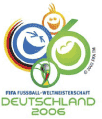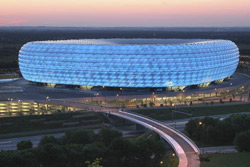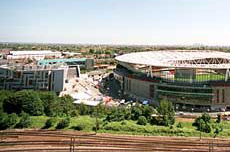 Every four years, over one billion people take pause for one month to view the most popular sporting event on Earth. The 2006 World Cup of Football (Soccer for us Yanks), showcases the 32 best teams from across the globe, assembled to see which one will lift the storied FIFA World Cup Trophy. No matter what happens, though, host country Germany and its strengthened infrastructure may be the real winner, writes Michael Jelks.
Every four years, over one billion people take pause for one month to view the most popular sporting event on Earth. The 2006 World Cup of Football (Soccer for us Yanks), showcases the 32 best teams from across the globe, assembled to see which one will lift the storied FIFA World Cup Trophy. No matter what happens, though, host country Germany and its strengthened infrastructure may be the real winner, writes Michael Jelks.

The World Cup format requires that the host nation have enough stadiums in place to successfully handle the influx of visiting spectators and member teams. The renovations and enhancements made to the stadiums in Germanywill exceed 1.4 billion Euros (1.78 Billion Dollars), with the improvements benefiting the local club teams and cities once the tournament has finished. While renovations of more modest stadiums are limited to seating, press box, and facilities improvements, the showcase stadiums in Munich and Berlin are monuments to Teutonic engineering. Whether these initiatives provide Germans a beneficial return on investment will depend greatly on past stadium improvement lessons.


Sense of Place
After the last World Cup goal has been scored and German clubs start utilizing the buildings, Germany will try to integrate the new stadiums and attendant infrastructure into local cities as seamlessly as possible, perhaps taking cues from previous host countries.
For example, when Italy hosted the World Cup in 1990, the Stadio Delle Alpi, home to powerhouse club Juventus, was constructed on the outskirts of the city of Turin.

Subsequent years have not been kind to the stadium, located too far from the center city, discouraging spectators from attending all but the most important matches. The building has a running track surrounding the field that serves no purpose, since designers failed to build the warm-up area necessary to stage running competitions. Additionally, advertising banners and stanchions make it impossible to see certain portions of the field from the lower level. All of these factors have led the locals to label the facility as "the stadium with no soul.." Recently, an investment group bought the property and began removing the track and correcting the errors of the original design.
In contrast to the Stadio Delle Alpi debacle, English Premier League team Arsenal have successfully completed the transition from the historic Highbury Park to the new Emirates stadium by creating what English architect Rod Sheard describes as, "a capacity to generate cultural memory, and do it as quickly as possible." The club was successfully able to transplant the sense of place by judiciously preserving the old stadium (which will be converted to residential units) and situating the new stadium only a mile away from the current edifice.

The aftermath of recent tournaments has shown that fans want a place that resonates with the club and the community. Building designers in Germany and elsewhere have attempted to meet this demand by constructing stadiums that are not simply places to watch a soccer match, but also an entertaining all-around experience. Developers now lavishly appoint the structures with shopping arcades, integrated sub-level parking garages, and multi-functional facilities (such as racing tracks) that allow for year-round usage of the buildings. Hotels and entertainment centers are also being erected adjacent to many venues in order to take advantage of these latest trends.
In the end, lasting significance of Germany's World Cup preparations will lie not only with how well the home team does in the tournament, but also on the return on its large investments to the stadiums and local infrastructure. Perhaps in another four years we will have gained a better perspective and see what trends have a lasting effect, and which ones may have missed the mark.
Interesting Factoids
In researching this article I happened across some interesting facts:
- There are more member nations that belong to FIFA (Fédération Internationale de Football Association) [207] than the United Nations [191]
- The final match of the tournament will attract an audience of over 1 billion viewers. In contrast the NFL Super Bowl attracts roughly 50 - 100 million viewers. Total viewership for the one month affair will top 30 billion.
- The largest Soccer Stadium is the Maracana, located in Rio De Janeiro, Brazil and has an official capacity of 125,000 with a record 200,000 people present for the 1950 World Cup Final between Brazil and Uruguay.
- The largest Soccer Stadium in Europe is Camp Nou located in Barcelona (seating capacity 98,000 spectators). Good luck in getting tickets to the annual Barcelona vs. Real Madrid Match - it is sold out every year.

Michael Jelks is the lead developer for Planetizen and an avid World Cup fan. He has studied abroad and watched numerous matches at Real Madrid's home stadium (Santiago Bernabeu) which unfortunately only holds 80,000 spectators.

Alabama: Trump Terminates Settlements for Black Communities Harmed By Raw Sewage
Trump deemed the landmark civil rights agreement “illegal DEI and environmental justice policy.”

Planetizen Federal Action Tracker
A weekly monitor of how Trump’s orders and actions are impacting planners and planning in America.

The 120 Year Old Tiny Home Villages That Sheltered San Francisco’s Earthquake Refugees
More than a century ago, San Francisco mobilized to house thousands of residents displaced by the 1906 earthquake. Could their strategy offer a model for the present?

Ken Jennings Launches Transit Web Series
The Jeopardy champ wants you to ride public transit.

BLM To Rescind Public Lands Rule
The change will downgrade conservation, once again putting federal land at risk for mining and other extractive uses.

Indy Neighborhood Group Builds Temporary Multi-Use Path
Community members, aided in part by funding from the city, repurposed a vehicle lane to create a protected bike and pedestrian path for the summer season.
Urban Design for Planners 1: Software Tools
This six-course series explores essential urban design concepts using open source software and equips planners with the tools they need to participate fully in the urban design process.
Planning for Universal Design
Learn the tools for implementing Universal Design in planning regulations.
Clanton & Associates, Inc.
Jessamine County Fiscal Court
Institute for Housing and Urban Development Studies (IHS)
City of Grandview
Harvard GSD Executive Education
Toledo-Lucas County Plan Commissions
Salt Lake City
NYU Wagner Graduate School of Public Service


























